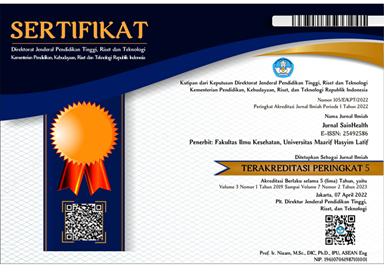KONDISI OPTIMUM ADSORPSI-FLUIDISASI ZAT WARNA LIMBAH TEKSTIL MENGGUNAKAN ADSORBEN JANTUNG PISANG
DOI:
https://doi.org/10.51804/jsh.v2i1.169.1-7Keywords:
banana inflorescence, adsorben, adsorption-fluidization, textile dyes wasteAbstract
To show that banana inflorescence has effective adsorbent for the adsorption of dyes (congo red, remazol yellow, remazol black and methylene blue) from textile dyes waste and also to detrmine the optimum conditions of variety of pH (4-10), temperature (30°C-90°C), and contact time (15-105 minute) on the percentage adsorption capacity of banana inflorescence. Textile dyes waste and their degradation products such as aromatic amines are highhly carcinogenic. Adsorption-fluidization is a new technology for treatment of waste water containing different types of dyes. Adsorption-fluidization process is adopted for adsorption of dyes from the textile dyes waste using banana inflorescence in treated form and were analysed by Utraviolet-Visible Spectroscopy. The results showed that the optimum condition from adsorption process of Congo Red dye by banana inflorescence was reached at pH 5 (1.78%), temperature 60°C (1.51%) and 45 minute contact time (1.63%). While Remazol Yellow dye optimum at pH 9 (4.29%), temperature 50°C (4.65%) and 75 min (1.83%). Another dye, Methylene Blue showed the optimum condition at pH 9 (0.36%), temperature 40°C (0.22%) and 45 min contact time of adsorption (0.43%). The last, Remazol Black dye was reached at pH 5 (0.56%), temperature 40°C (0.56%) and 75 min contact time (0.56%).References
Abbasi, Z., Alikarami, M., Nezhad, E.R., Moradi, F., Moradi, V., Adsorptive Removal of Co2+ and Ni2+ by Peels of Banana from Aqueous Solution, Universal Journal of Chemistry, 2013, Vol. 1(3), pp. 90-95.
Agustina, T.E dan Amir, M., 2012, Pengaruh Temperatur Dan Waktu Pada Pengolahan Pewarna Sintetis Procion Menggunakan Reagen Fenton, Jurnal Teknik Kimia No. 3, Vol. 18.
Buthelezi, S.P., Olaniran, A.O., Pillay, B., Textile Dye Removal from Wastewater Effluents Using Bioflocculants Produced by Indigenous Bacterial Isolates, Molecules, 17, 2012, pp. 14260-14274.
Elaveniya, E., and Jayamuthunagai, J., Recent Trends in Biotechnology and Chemical Engineering Functional, Physicochemical and Anti-oxidant properties of Dehydrated Banana Blossom Powder and its Incorporation in Biscuits, International Journal of ChemTech Research, 2014, Vol.6, No.9, pp 4446-4454.
Gonawala, K.H., Mehta, M. J., Removal of Color from Different Dye Wastewater by Using Ferric Oxide as an Adsorbent, Int. Journal of Engineering Research and Applications, 2014, Vol. 4, Issue 5( Version 6), pp.102-109.
Gottipati, R., dan Mishra, S., Application of Biowaste (Waste Generated in Biodiesel Plant ) as an Adsorbent for the Removal of Hazardous Dye-Methylene Blue- from Aqueous Phase, Brazilian Journal of ChemicalEngineering, 2010, Vol. 27, No. 02, pp. 357 – 367.
Gunavathy, N., Murugavel, S.C., Corrosion inhibition study of bract extract of Musa acuminatainflorescence on mild steel in hydrochloric acid medium,IOSR Journal of Applied Chemistry, 2013,Volume 5(2), pp.29-35.
Hauser, P., 2011, Advances in Treating Textile Effluent, Chapter 5: Textile Dyeing Wastewater Treatment by Wang, Z., Xue, M., Huang, K., Liu, Z., Croatia: Intech.
Hidayah, N., Deviyani, E., Wicakso, D.R., Adsorpsi Logam Besi (Fe) Sungai Barito Menggunakan Adsorben dari Batang Pisang, Konversi, 2012, Volume 1(1), pp.19-26.
Kumar, K.P.S., Bhowmik, D., Duraivel, S., Umadevi, M., Traditional and Medicinal Uses of Banana, Journal of Pharmacognosy and Phytochemistry,2012,Vol. 1(3), pp. 51-62.
Kusumaningsih, T., Masykur A., Supriyanto, R., Adsorpsi Zat Warna Remazol Yellow FG pada Limbah Tekstil oleh Alang-alang (Imperata cylindrica (L) Raeush), 2006, Biofarmasi, Volume 4(1), pp. 27-33.
Lasmana, A., Mukhtar, A., Tamboesai, E.M., 2016, Adsorpsi Zat Warna Congo Red Menggunakan Zeolit Alam Teraktivasi, Repository University of Riau.
Maghfiroh, L., Ulfin, I., Juwono, H., Pengaruh pH terhadap Penurunan Zat Warna Remazol Yellow FG oleh Adsorben Selulosa Bakterial Nata De Coco, Jurnal Sains dan Seni, 2016, Vol.5(2), pp. C-126 – C-129.
Mokbel, M.S., Hashinaga, F., Antibacterial and Antioxidant Activities of Banana (Musa, AAA cv. Cavendish) Fruits Peel, American Journal of Biochemistry and Biotechnology, 2005, Vol 1 (3), pp. 125-131.
Nelson, S.C., Ploetz, R.C., Kepler, A.K., 2006, Musa species (banana and plantain).
Ouasif, H., Yousfi, S., Bouamrani,M.L., El Kouali, M., Benmokhtar, S., Talbi, M., Removal of A Cationic Dye from Wastewater by Adsorption onto Natural Adsorbents, J. Mater. Environ. Sci., 2013, Vol. 4 (1), pp.1-10.
Rachakornkij, M., Ruangchuay, S., Songklanakarin, S.T., Removal of Reactive Dyes from Aqueous Solution using Bagasse Fly Ash, J. Sci. Technol., 2004,Vol. 26, pp. 13-24.
Suyanto, 2015, Biopolimer Kitosan, Fluidisasi, dan Aplikasinya, Surabaya: Airlangga University Press.
Wickramarachchi, K.S., and Ranamu khaarachchi, S.L., Preservation of Fiber-Rich Banana Blossom as a Dehydrated Vegetable, ScienceAsia, 2005, Vol31, p265-271.
Zuorro, A., Lavecchia, R., Medici, F., Piga, L., Spent Tea Leaves as a Potential Low-cost Adsorbent for the Removal of Azo Dyes from Wastewater,Chemical Engineering Transactions ,2013, Vol. 32, pp. 19-24.
Downloads
Published
Issue
Section
License
Jurnal SainHealth is licensed under Creative Commons Attribution 4.0 International License.
Under the following terms:
Attribution — You must give appropriate credit, provide a link to the license, and indicate if changes were made. You may do so in any reasonable manner, but not in any way that suggests the licensor endorses you or your use.
No additional restrictions — You may not apply legal terms or technological measures that legally restrict others from doing anything the license permits.












